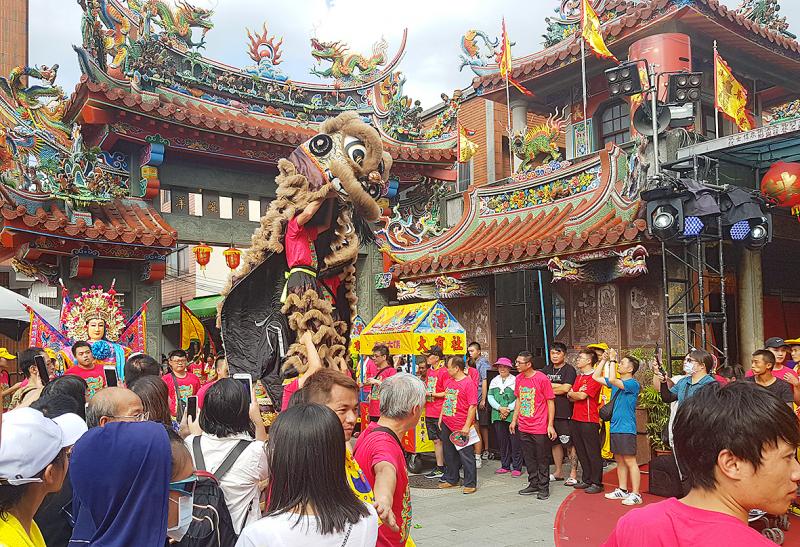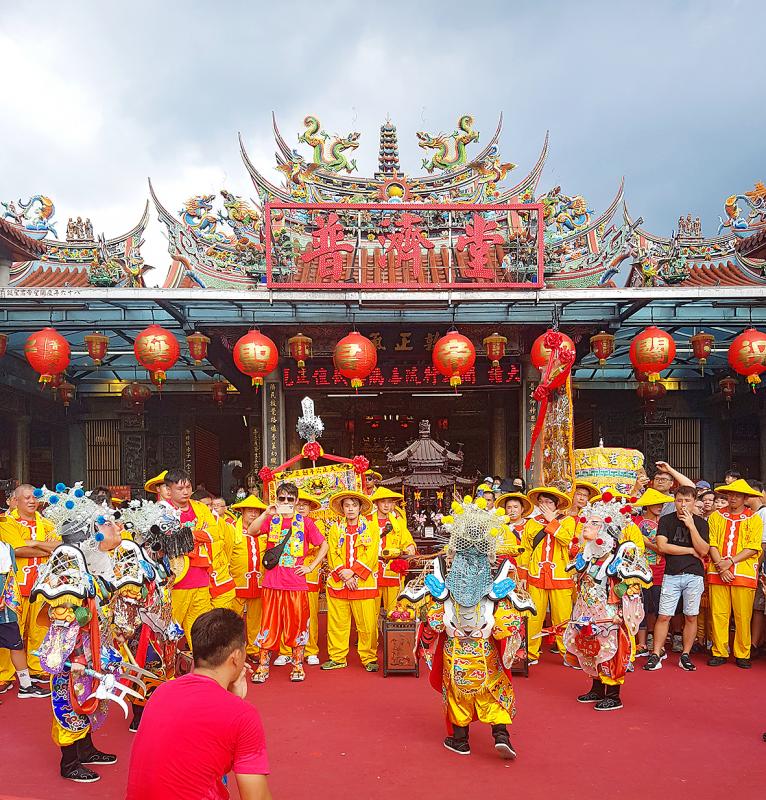Architect Tammy Liu (劉真蓉) recalls being stumped when studying in the Netherlands a teacher asked her to describe Taiwanese culture. No matter how much she pondered, nothing came to mind.
“Our education system doesn’t teach us about Taiwanese culture — at least when I was in school,” Liu, 40, tells the Taipei Times.
And that culture for Liu is small town Taiwan, with its temple festivals and performance troupes and old streets (老街), with all manner of delicacies and handicrafts.

Photo: Noah Buchan, Taipei Times
Liu’s experience overseas is common for Taiwanese. Raised in an education system that downplays the nation’s vast and fascinating folk culture or views its association with society’s shadier elements as an embarrassment, the idea that it could in part define Taiwanese identity was avoided.
No longer. Today the president appears at Jenn Lann Temple’s Mazu Pilgrimage or the culture minister shows up to the opening of a new building at Tainan’s Nankunshen, because they know that doing so attracts votes at election time and brings in tourist dollars. But greater acceptance among the mandarin class has come at the expense of authenticity.
UPDATING TRADITION

Photo: Noah Buchan, Taipei Times
Daxidaxi (大溪大禧) manages to avoid these pitfalls. The two-week cultural festival, which is curated by Liu and supported by the Dasi Wood Art Ecomuseum (桃園市立大溪木藝生態博物館), is taking place in and around Puji Temple (普濟堂) in Taoyuan’s Dasi Township (大溪) until tomorrow.
In addition to parading Guan Gong (關公), the temple’s patron deity and the Chinese god of war and martial arts, around Dasi today and tomorrow, the festival has included music performances that combine temple tunes with rap, exhibitions of photos of temple volunteers and local artisans, as well as an installation on how to make a vow to the god.
The festival taps into the emerging interest in old-time Taiwan by updating some traditions so as to attract a broader audience, while retaining the traditional elements that make Taiwan’s local culture unique.

Photo: Noah Buchan, Taipei Times
Though originally from Taichung’s Fengyuan District (豐原) and only having visited Dasi a couple of times before starting Daxidaxi three years ago, Liu says that there is a vibe that unites all Taiwanese towns: a central temple surrounded by a commercial district — what Liu calls a “dream hometown” because it has preserved much of its traditional architecture and traditional folk and craft culture.
“The style reminds me of my hometown,” Liu, whose previous curatorial foray includes the first Nuit Blanche in Taipei, says motioning towards Puji Temple.
The first Daxidaxi began in 2017, after a local museum commissioned Liu to re-design elements of its parade — from the towels emblazoned with Guan Gong and the talismans that are handed out to worshippers, to the flags that pilgrims carry while on the two-day parade.

Photo courtesy of Daxidaxi
Design leader Liao Hsiao-tzu (real name Liao Chun-yu, 廖俊裕) says that creating designs that would appeal to locals, while breathing new life into a somewhat staid form, required months of research.
“The image of deities will evolve with every generation,” he says. “The purpose is to design in such a way that the local people look at the results and say to themselves: yes, this is ours, this is us.”
Liao says that designers typically impose their own aesthetic ideas on a project — often influenced by Japanese or American aesthetics.

Photo courtesy of DaxiDax
“The aesthetic that people have who grew up around temples is different than professional designers,” he says, motioning towards the elaborate and intricate and colorful designs of the temples. “I wanted something that clearly reflects the local culture.”
And that means incorporating into his designs the colors commonly seen on the intricate temple sculptures and architecture.
If Liao's design aesthetics are based on temple colors and shapes, Liu takes inspiration from Japan for the opening day of the festival, which she calls “parade warming.”
“This is a warming up to make people aware of the parade’s existence,” she says. “So for these two weeks we can show everybody the traditional lifestyle of Dasi and the traditional lifestyle of Taiwan.”
Much of these are on display on the third floor of an exhibition space near the temple. Liu shows me life-sized photos of people from the community, including volunteers at the temple, a local craftsmen and a Eight Generals (八家將) troupe member.
Before heading up to the third floor, I visit an installation on the second floor and pray to Guan Gong.
HARD SELL
Convincing locals to modify the look of the parade and expand its length from a two-day parade to a two-week festival wasn’t an easy sell, Liu says.
In the first year, she visited the temple every second day to speak with locals and canvas their opinions. Additionally, the parade has 32 troupes, each with their own ideas about how traditions should be updated or maintained, and in what order they should appear on the first day of the festival.
“It’s a political issue,” Liu said of the squabbling among the different troupes.
“They also think that I’m an outsider who doesn’t understand [the community],” she says.
Although changes have been made to the parade, they are largely superficial. The flags may not mimic the imperial style of old, or the talismans bear the regal colors of the emperor, but the reality is the parade route and religious folk icons such as the Eight Generals, lion dancers and the Third Prince (santaizi, 三太子) appear in the same traditional costumes.
But changing the look of the original parade was never the purpose, Liu says. Instead, it was to attract those to Dasi who pine for some nostalgia of Taiwan’s past.
“And that’s what a dream hometown is all about.”
■ For more information, visit: www.facebook.com/DaxiCulFes

A vaccine to fight dementia? It turns out there may already be one — shots that prevent painful shingles also appear to protect aging brains. A new study found shingles vaccination cut older adults’ risk of developing dementia over the next seven years by 20 percent. The research, published Wednesday in the journal Nature, is part of growing understanding about how many factors influence brain health as we age — and what we can do about it. “It’s a very robust finding,” said lead researcher Pascal Geldsetzer of Stanford University. And “women seem to benefit more,” important as they’re at higher risk of

March 31 to April 6 On May 13, 1950, National Taiwan University Hospital otolaryngologist Su You-peng (蘇友鵬) was summoned to the director’s office. He thought someone had complained about him practicing the violin at night, but when he entered the room, he knew something was terribly wrong. He saw several burly men who appeared to be government secret agents, and three other resident doctors: internist Hsu Chiang (許強), dermatologist Hu Pao-chen (胡寶珍) and ophthalmologist Hu Hsin-lin (胡鑫麟). They were handcuffed, herded onto two jeeps and taken to the Secrecy Bureau (保密局) for questioning. Su was still in his doctor’s robes at

Last week the Democratic Progressive Party (DPP) said that the budget cuts voted for by the China-aligned parties in the legislature, are intended to force the DPP to hike electricity rates. The public would then blame it for the rate hike. It’s fairly clear that the first part of that is correct. Slashing the budget of state-run Taiwan Power Co (Taipower, 台電) is a move intended to cause discontent with the DPP when electricity rates go up. Taipower’s debt, NT$422.9 billion (US$12.78 billion), is one of the numerous permanent crises created by the nation’s construction-industrial state and the developmentalist mentality it

Experts say that the devastating earthquake in Myanmar on Friday was likely the strongest to hit the country in decades, with disaster modeling suggesting thousands could be dead. Automatic assessments from the US Geological Survey (USGS) said the shallow 7.7-magnitude quake northwest of the central Myanmar city of Sagaing triggered a red alert for shaking-related fatalities and economic losses. “High casualties and extensive damage are probable and the disaster is likely widespread,” it said, locating the epicentre near the central Myanmar city of Mandalay, home to more than a million people. Myanmar’s ruling junta said on Saturday morning that the number killed had